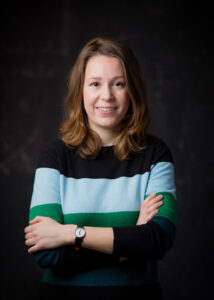‘That day my field of research was born’
Jorinde van de Vis, former Nikhef PhD student now postdoc DESY, Hamburg
‘In 2012 I was a second year physics student in Leiden. I was working, I believe, on an essay on the history of mathematics. I saw the news of CERN on television that evening. I felt curiosity above all. I immediately wanted to know what that Higgs particle was all about. On the news and in the newspapers I also saw that Dutch people were working on it. I had no idea that they would one day be my colleagues and that I would be working on the Higgs particle myself.
But I haven’t contributed anything to the discovery. I would almost think that the Higgs particle is even more important now than it was ten years ago. At that time physicists expected many more new particles to be found. However, that did not happen. And so we still don’t know what dark matter is, where the masses of neutrinos come from, why there is much more matter than antimatter. It seems that the Higgs particle may be the key to all those fundamental questions.
My question to the Higgs particle is simple: what yet unknown particles do you have interactions with? But of course that is secretly just the question that is always in play in our profession, are there more particles that can answer our open questions? For my own subject, cosmology, I am actually looking forward to the first measurements of gravitational waves from the episode after the Big Bang in which particles gained mass in a phase transition. That would be a test of my ideas about the role of the Higgs particle in the very early universe. The discovery of the Higgs particle was roughly the beginning of the field of research in which I now work. That the Higgs particle exists and how the Higgs field couples to other particles is what you need to know to make models for the early universe.’
This interview was originally published in Nikhef magazine DIMENSIES #7
